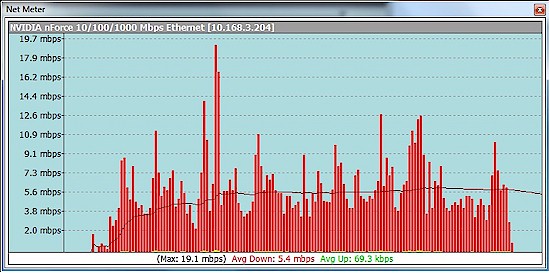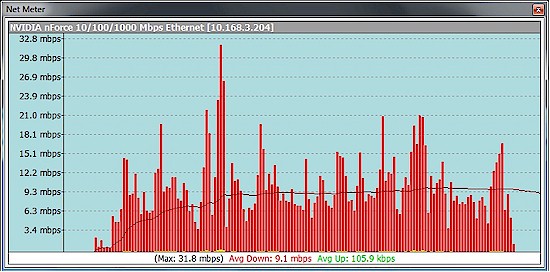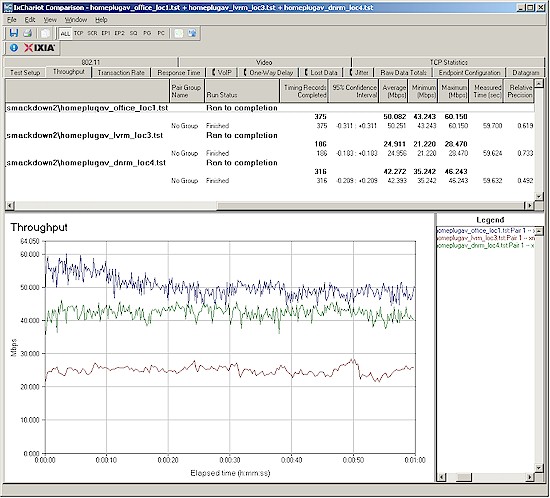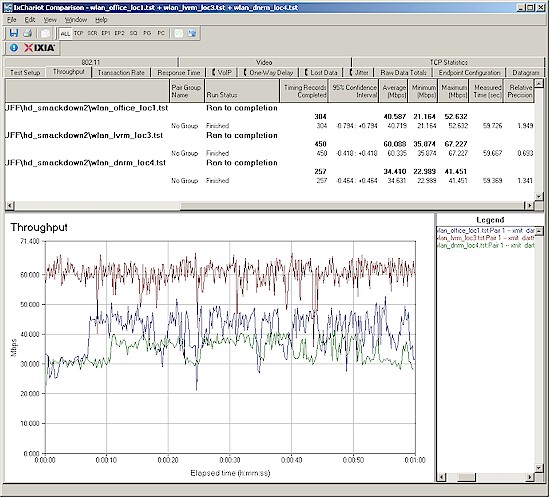Introduction
The last time I pitted powerline vs. wireless technology to see if either could handle the demands of HD video streaming was over two years ago. 802.11n wireless was still in "draft" form and powerline networking was still locked in a battle between incompatible HomePlug and UPA technologies.
As I write this in late summer 2010, 802.11n has been finalized for almost a year and HomePlug AV seems to have emerged as the leading technology for powerline networking.

Can either 802.11n or HomePlug AV keep up with this action?
My recent roundup of HomePlug AV adapter kits found them more alike than different and almost all capable of delivering steady throughput in the mid-to-high 40 Mbps range. But while these results are significantly improved from past tests, HomePlug AV still doesn’t have the rock-solid throughput that a wired Ethernet connection provides. So the only way to really know if either wireless or powerline can provide trouble-free HD streaming is to use both with actual HD streams.
How We Tested
I ran all of my experiments using a Synology DS109+, as the streaming data source. The NAS Charts show it (you need to show Archived products) at 59 MB/s read using the iozone benchmark and 73 MB/s read using the Windows File Copy benchmark. Multiple either number by 8 and you’ll see that the DS109+ can have files read from it (as a media player would) at well over 400 Mbps.
For my player, I used my Acer Aspire 1810T, which has HDMI out and plays both 720p and 1080p content nicely. Since I used Quicktime clips, I used Quicktime 7.6.5 for playback.
In the HomePlug AV roundup, I noted that the Plaster Networks adapters were the worst for dropouts, so I used them as the powerline test pair. One adapter was plugged into the outlet outside the office, so that it was not behind the AFCI breaker that protects the room and the other adapter was moved to a living room outlet, then a dining room outlet. Those test locations correspond to wireless test Locations C and D, as described here.
The wireless testing was done with the NETGEAR WNDR3700 that I use as my home’s wireless router and an Intel Wi-Fi Link 5300 mini PCIe card in the Acer Aspire 1810T notebook. The 2.4 GHz band was used in 20 MHz bandwidth (up to 130 Mbps) mode. The WNDR3700 is in a centrally-located lower level utility room and not the usual office test Location A. The Living Room and Dining Room locations correspond to test Locations C and D.
What does HD Need?
As noted in the Video Streaming Need To Know, and in the previous Smackdown, it’s essential that you understand the bandwidth demands of the content that you’ll be trying to stream. The best way to do this is to play the content from your networked source using an Ethernet connection while running a bandwidth metering program.
I’ve used both ReadError’s NetMeter (free) and Hoo Technologies’ Net Meter ($20), but prefer the latter because of its better plotting options and ability to clear the plot without killing and restarting the program.
You might frequently hear 20 Mbps or thereabouts described as the required bandwidth for HD streaming. This gets us in the proper ballpark, but doesn’t paint a complete picture.
I used Apple’s QuickTime Pro 7 to download 720p and 1080p movie trailers to use as test material. Figure 1 shows the properties of the 720p version of the Megamind trailer 3 used for testing. Note that the data rate is stated as 5.52 mbits/sec. So that should be a piece of cake for even an 802.11g wireless connection, right?
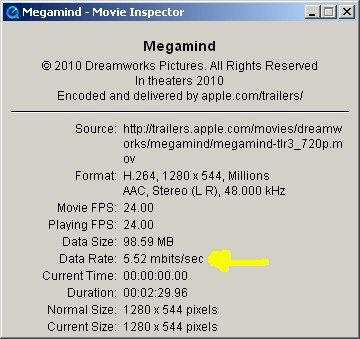
Figure 1: Megamind 720p trailer 3 properties
Now look at the actual bandwidth profile taken with Hoo Tech’s NetMeter in Figure 2. Although the Avg Down throughput shown as 5.4 Mbps matches nicely with the file data rate properties, you can see a maximum of 19.1 Mbps, with frequent excursions above 10 Mbps. So the Quicktime properties Data Rate is obviously the average data rate, which doesn’t help in determining what you need for flawless playback.
Figure 2: Megamind 720p trailer 3 bandwidth profile
Looking at the 1080p version of the same trailer, Figure 3 shows almost a 2x boost in average data rate to 9.4 Mbps.
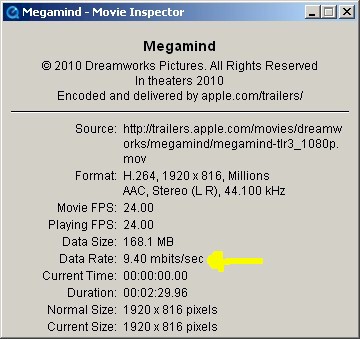
Figure 3: Megamind 1080p trailer 3 properties
Figure 4 shows the bandwidth profile, with an average down rate of 9.1 Mbps closely matching the 9.4 Mbps Quicktime average data rate. As we’d expect, the profile looks very similar in shape to the 720p profile. But the peak rate has almost doubled from 19.1 to 31.8 Mbps!
Figure 4: Megamind 1080p trailer 3 bandwidth profile
So 1080p can still be doable with powerline networking or 802.11n wireless with a strong signal. But bandwidth headroom is significantly reduced.
The Test
I ran IxChariot throughput tests for powerline and wireless connections in all three test locations, so that we have actual throughput measurements to correlate with the observed streaming performance. Powerline throughput results are summarized in Figure 5.
Figure 5: IxChariot powerline throughput summary
Note that the living room test showed only 25 Mbps average powerline throughput, but no throughput dropouts. I have no explanation for the change from the HomePlug AV roundup results.
Figure 6 summarizes the wireless performance tests. This time, the living room location has the average highest throughput—60 Mbps. But higher throughput variation than powerline still puts 802.11n wireless at an HD streaming disadvantage.
Figure 6: IxChariot 802.11n throughput summary
After the throughput measurements, I played 720p and 1080p Megamind trailer clips and watched for playback errors. The results for the 720p clips are summarized in Table 1 and in Table 2 for 1080p. The corresponding IxChariot average throughput results are shown next to each of the results for easy reference.
| Location | HomePlug AV | 802.11n | ||
|---|---|---|---|---|
| Behavior | Avg Thruput | Behavior | Avg Thruput | |
| Office | One or two frame drops during fast action | 50 Mbps | No Errors | 41 Mbps |
| Living Room | No Errors | 25 Mbps | No Errors | 60 Mbps |
| Dining Room | No Errors | 42 Mbps | One freeze (recovered) | 34 Mbps |
Table 1: HD streaming behavior summary – 720p
While neither method produced trouble free playback 100% of the time during this short experiment, it’s clear that there were fewer, more minor problems with 720p playback than with 1080p.
| Location | HomePlug AV | 802.11n | ||
|---|---|---|---|---|
| Behavior | Avg Thruput | Behavior | Avg Thruput | |
| Office | Multiple frame drops during fast action | 50 Mbps | Multiple frame drops during fast action | 41 Mbps |
| Living Room | Multiple frame drops, short freezes during fast action | 25 Mbps | Multiple frame drops during fast action | 60 Mbps |
| Dining Room | Multiple frame drops, short freezes during fast action | 42 Mbps | Two freeze (recovered); one 5 second hang; frame drops during fast action | 34 Mbps |
Table 2: HD streaming behavior summary – 1080p
Of particular note is I didn’t get a crash or unrecoverable hang in any of the tests. The longest that the picture froze was for around 5 seconds with the lowest bandwidth 802.11n connection and 1080p.
Conclusion
There is both good and bad news in these results. The bad is that if you’re looking for flawless 1080p HD playback from either 802.11n or powerline, you still won’t get it. At the risk of repeating myself (again and again), if you want trouble free 1080p HD playback, use Ethernet, a local (to the player) file or a networked player with a big, intelligent buffer. 100 Mbps Ethernet will work just fine; you don’t need Gigabit.
The good news is that if you can be satisfied with 720p or "1080p" files in formats encoded with lower bandwidth codecs, you have a good shot at getting a pretty enjoyable viewing experience with HomePlug AV. And if your distances are short, neighboring wireless traffic is low and you keep everyone else off your WLAN, you might even be able to watch 720p files in peace via 802.11n

